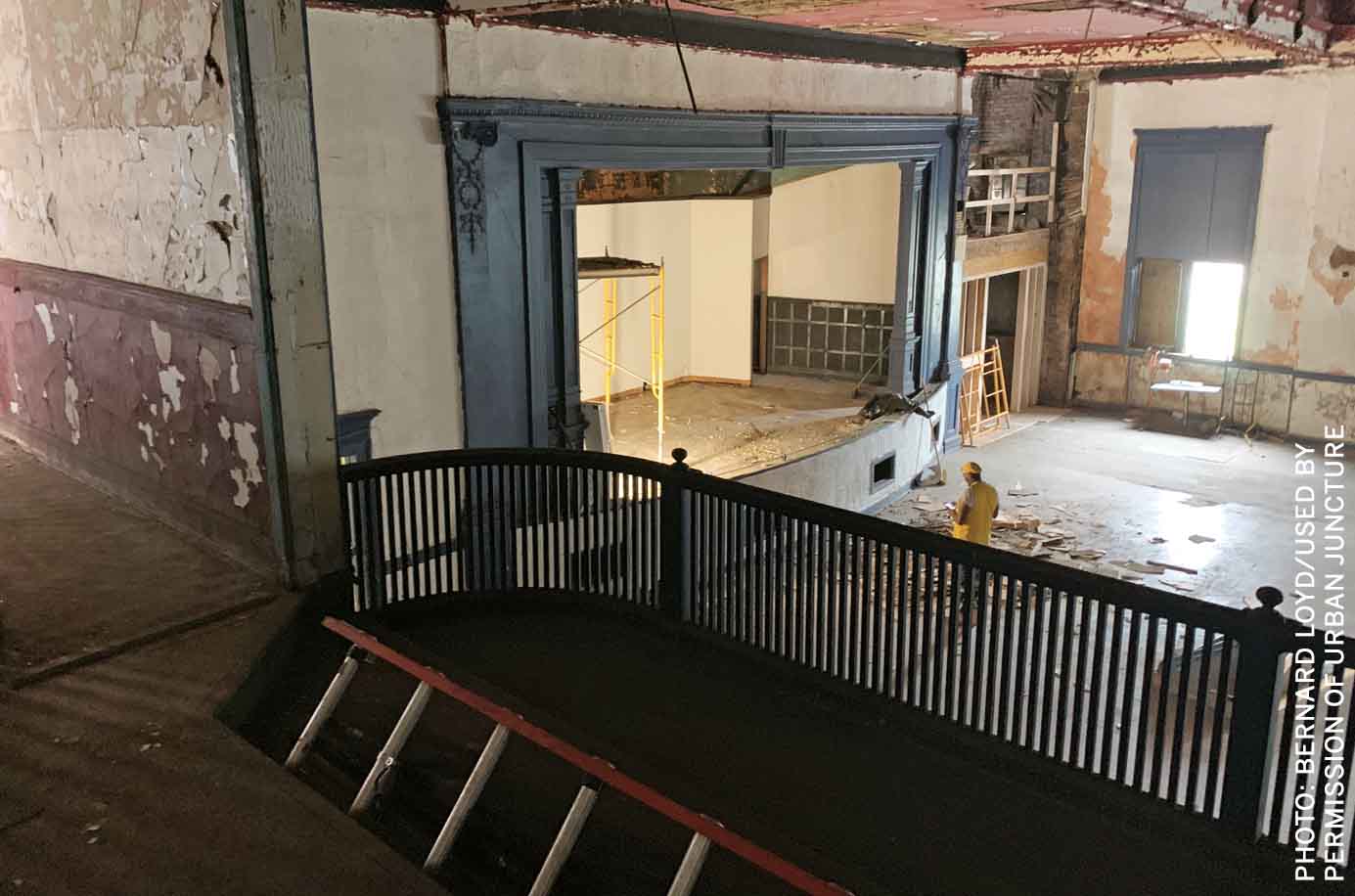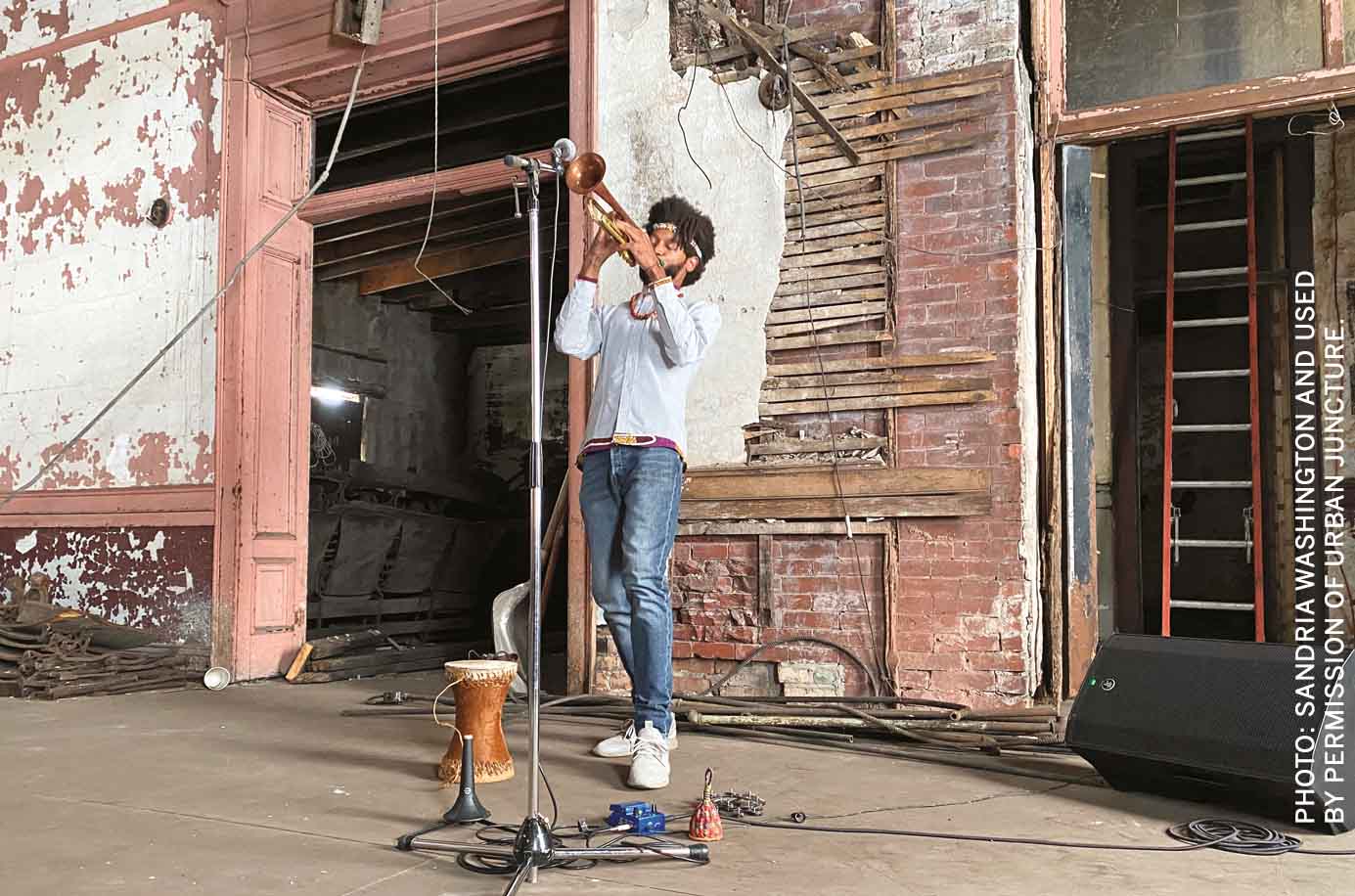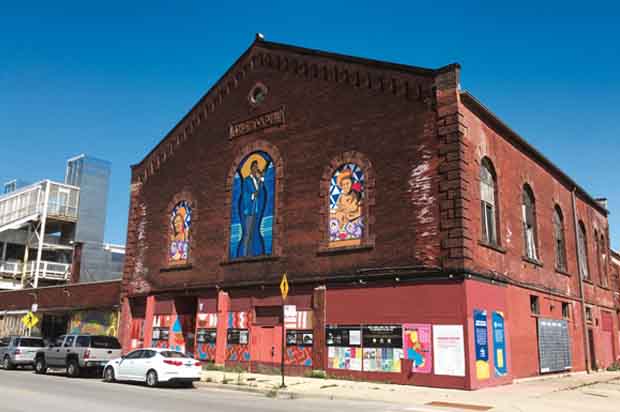Visionary Black artists, activists and community developers have transformed abandoned buildings and vacant lots into a network of bustling community arts and recreational centres in neighbourhoods across Chicago’s South Side. For years, these spaces have anchored their local economies, created vibrant cultural opportunities for their communities and acted as a bulwark against disinvestment. Community residents toiled to sustain these spaces despite insufficient funding and attention by the city government, private funders and the media.
Today, these longstanding community hubs form the backbone of a new cultural economy of music venues, galleries, theatres, house museums, creative incubators, artist lofts, wine bars, brew pubs, coffee shops and restaurants that Black entrepreneurs, artists and developers are building in neighbourhoods from Bronzeville to Washington Park to Woodlawn and South Shore. This new cultural economy has the potential to reshape Chicago’s tourism map, create equitable economic opportunities and enhance the quality of life for long-term residents on the South Side. There is growing support in both the city government and the philanthropic community to fund these projects. Nonetheless, it is still a delicate ecosystem that is vulnerable to being swallowed up by more powerful economic forces with deep political connections unless planners, elected officials and powerful private stakeholders take continuous active measures to support the artists, activists, entrepreneurs and community developers forging this new cultural economy.
The Obama Presidential Center is scheduled to break ground in Jackson Park on Chicago’s South Side in August this year. The $500 million museum and civic center anticipates attracting 625,000–760,000 visitors with an economic impact of $246 million per year. Without question, the Obama Center will change the economy and spatial landscape of the South Side. The question is: how equitable will that transformation be?

Chicago has a long history of segregation, disinvestment, racially discriminatory land use policies and racially discriminatory financing policies in both the public and private sectors. Today, maps of Chicago charting a wide variety of spatial inequities all look remarkably similar. Chicago’s predominantly white North Side has far greater access to fresh food, hospitals, public transportation, employment opportunities, home loans and other resources than the predominantly Black and Latinx South and West Sides. Churches, performance venues, manufacturing facilities, warehouses, schools, post offices, banks and other historically or architecturally significant buildings sit empty, in various stages of disrepair, throughout the South and West Sides.
Deep patterns of spatial inequity reverberate through the public discourse about the impact of the Obama Presidential Center
These deep patterns of spatial inequity reverberate through the public discourse about the impact of the Obama Presidential Center on the neighbourhoods that surround it. There is both excitement for the Center’s promise of transformational economic growth and concern that it will lead to gentrification, displacement and a lack of economic benefits for long-time residents.
Black artists, activists and community developers have converted abandoned and underused buildings into lively centers of commerce and cultural activity in the neighbourhoods adjacent to the Obama Center location:
- Theaster Gates and Rebuild Foundation restored a vacant historic bank building in South Shore and reopened it as the Stony Island Arts Bank, a hybrid gallery space, library, media archive and community centre.
- Urban Juncture transformed a mostly abandoned multi-use building at the 51st Street Green Line Station in Bronzeville into a dynamic ecosystem of incubators including the Bronzeville Incubator, Bronzeville Cookin’, a Culinary Incubator offering ‘Cuisines of the African Diaspora’ and Boxville, a shipping container marketplace that currently houses 10 small, start-up enterprises.
- Blacks in Green converted two empty storefronts in West Woodlawn into the Green Living Room, which includes training facilities for jobs in the green economy, community meeting spaces, a coffee shop, retail space and a performance area.
I use the term ‘poly-use community hubs’ to describe these dynamic public spaces anchored by arts, cultural and recreational programming. Poly-use community hubs combine a broad array of for-profit, non-profit and public services and feature robust opportunities for small businesses, economic development, green space and easily accessible public services. As money and tourists begin to flood into the neighbourhoods surrounding the Obama Center, poly-use community hubs with local ownership/leadership offer a resilient model for equitable hyperlocal economic and community development.
I am currently working with Urban Juncture on the restoration of The Forum, a stunning 1897 performance and civic hall in Bronzeville. For the first three quarters of the 20th century, The Forum stood at the center of the cultural, political and retail life of Chicago’s Black Metropolis. It closed in the 1970s when Bronzeville’s population dropped precipitously and sat empty for almost 50 years. It was scheduled for demolition by the city in 2011 when Urban Juncture stepped in to purchase it. I believe The Forum is a perfect example of the transformative possibilities of poly-use community hubs.
Black artists, activists and community developers have converted abandoned and underused buildings into lively centers of commerce and cultural activity
The Forum is adjacent to the 43rd Street Green Line station. Today, despite the more than 1,000 people who board the L train at the 43rd Street Green Line station on a daily basis and an Average Annual Daily Traffic (AADT) count of nearly 9,000, there are no retail enterprises within a block of the station. There are vacant lots across from The Forum on both 43rd Street and Calumet.
The Forum complex includes the 550-seat Forum Hall, seven retail units and additional spaces that can be used for a variety of hospitality and entertainment purposes. The Forum complex will house a bustling cluster of for-profit and non-profit enterprises devoted to telling complex, vital stories about the Black experience, culture and history in Chicago and the United States.

50 years of vacancy has taken its toll on The Forum. Urban Juncture has stabilised the building’s roofs and masonry and many of its floors and windows. However, there is still an enormous amount of work to be done to restore it to its former glory. The restoration and rehabilitation of abandoned buildings – particularly ones that qualify for landmark designation – create a number of financing, construction and engineering challenges. To be successful, The Forum will require a complex mixture of funding sources including TIF, municipal grants, federal and state historic tax credits, debt equity and philanthropy.
The City of Chicago has introduced several ambitious initiatives designed to catalyse equitable economic growth on the city’s South and West Sides:
- The $750 million INVEST South/West initiative targets 12 commercial corridors in 10 communities. In March, the city announced it will invest $65 million in the first three INVEST South/West competition winners. Each of the selected projects consists of the restoration of abandoned or underused public buildings into mixed-use developments that include retail and some arts or recreational programming.
- The Neighbourhood Opportunity Fund (NOF), which began in 2016, uses funds generated from new development in the Loop (Chicago’s central business district) to invest in developments in retail corridors in the South and West Sides. NOF Small Project grants of up to $250,000 are intended to offer start-up capital to entrepreneurs and small businesses to launch enterprises that will have a ‘catalytic impact’ on their neighbourhoods (City of Chicago, 2021).
- The newly announced 77 Arts programme is a $60 million “citywide arts recovery and reopening programme,” designed to fund arts activities in each of Chicago’s 77 community areas (City of Chicago, 2021).
These programmes cannot rectify decades of racially discriminatory financing policies in both the public and private sectors that continue to impact Black community developers’ ability to access capital. Nonetheless, these ambitious programmes are likely to catalyse more equitable economic and spatial development in neighbourhoods in the South and West Sides.
As I walk through the glorious Forum Hall or stand amidst the rubble of the newly excavated basement of the West Annex retail units, or step out onto the roof as a Green Line train rumbles by, I feel as if I can see a future. It’s not the future, not by a long shot; but it is a future that is within grasp.
The artist in me sees a bustling building filled with live music, theatre, dance, visual arts, community photography projects, knitting circles and book clubs, recording studios for music and podcasts, green screen studios, and post-production facilities; safe, fun places for kids to go after school to make stop-motion animation, live theatre and other dynamic education experiences, delicious food and space to hang out and talk with friends, gathering spaces for community groups, panel discussions, weddings, galas and civic debate.
The artist in me sees a bustling building filled with live music, theatre, dance and visual arts
The planner in me sees a South Side with a cultural economy anchored (but not dominated) by the Obama Center, grounded in years of effort by visionary Black artists, activists and entrepreneurs like Theaster Gates, Bernard Loyd, Naomi Davis, Eric Williams and so many others. A Chicago where individuals with big ideas but limited access to capital can leverage innovative funding programmes to launch restaurants, performance venues, galleries and boutiques in retail corridors that flourish after years of disinvestment. A thriving economy that generates economic benefits for long-term residents and a replicable model for cities across the country that want to spur equitable hyperlocal economic and community development.
At the same time, the cynic in me sees powerful developers co-opting much of the funding from these new municipal funding initiatives: bankers unwilling to provide debt equity necessary to capitalise projects they don’t fully understand, economic development officials continuing to focus their efforts on recruiting major national retailers and fulfillment centres. Aldermen blocking individual projects that don’t fit their personal political agendas, gentrification and displacement and the economic growth created by the Obama Center primarily benefiting the wealthy and powerful.
The Obama Center and the $750 million of Invest South/West funding will dramatically change the economy and spatial landscape of Chicago’s South Side over the next decade. What that new future looks like – and who benefits – is still uncertain. Funding choices made by elected officials, planners, bankers and philanthropists will place a thumb on the scale in determining what this future looks like. Transforming abandoned buildings and vacant lots into locally owned, poly-use community hubs like The Forum provide a bridge between the vibrant cultural heritage of the Black South Side and a new resilient and equitable cultural economy. Public and private funders should use all the tools in their arsenals to ensure these spaces have the greatest opportunity to anchor this new equitable cultural economy.



Comments (0)